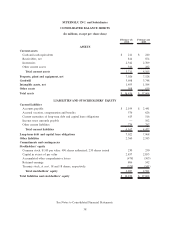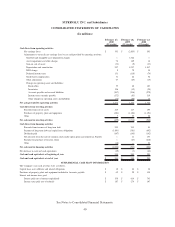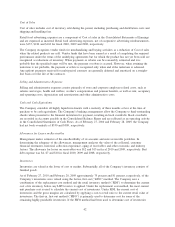Albertsons 2010 Annual Report Download - page 51
Download and view the complete annual report
Please find page 51 of the 2010 Albertsons annual report below. You can navigate through the pages in the report by either clicking on the pages listed below, or by using the keyword search tool below to find specific information within the annual report.forms covering substantially all employees who meet eligibility requirements. The determination of the
Company’s obligation and related expense for Company-sponsored pension and other postretirement benefits is
dependent, in part, on management’s selection of certain actuarial assumptions in calculating these amounts.
These assumptions include, among other things, the discount rate, the expected long-term rate of return on
plan assets and the rates of increase in compensation and healthcare costs.
Derivatives
The Company’s limited involvement with derivatives is primarily to manage its exposure to changes in interest
rates and foreign exchange rates. The Company uses derivatives only to manage well-defined risks. The
Company does not use financial instruments or derivatives for any trading or other speculative purposes.
Stock-based Compensation
The Company uses the straight-line method to recognize compensation expense based on the fair value on the
date of grant, net of the estimated forfeiture rate, over the requisite service period related to each award. The
fair value of stock options is estimated using the Black-Scholes option pricing model, which incorporates
certain assumptions, such as risk-free interest rate, expected volatility, expected dividend yield and expected
life of options.
Income Taxes
Deferred income taxes represent future net tax effects resulting from temporary differences between the
financial statement and tax basis of assets and liabilities using enacted tax rates in effect for the year in which
the differences are expected to be settled or realized.
The Company is currently in various stages of audits, appeals or other methods of review with taxing
authorities from various taxing jurisdictions. The Company establishes liabilities for unrecognized tax benefits
in a variety of taxing jurisdictions when, despite management’s belief that the Company’s tax return positions
are supportable, certain positions may be challenged and may need to be revised. The Company adjusts these
liabilities in light of changing facts and circumstances, such as the progress of a tax audit. The Company also
provides interest on these liabilities at the appropriate statutory interest rate. The Company recognizes interest
related to unrecognized tax benefits in interest expense and penalties in Selling and administrative expenses in
the Consolidated Statements of Earnings.
Net Earnings (Loss) Per Share
Basic net earnings (loss) per share is calculated using net earnings (loss) available to stockholders divided by
the weighted average number of shares outstanding during the period. Diluted net earnings (loss) per share is
similar to basic net earnings (loss) per share except that the weighted average number of shares outstanding is
after giving effect to the dilutive impacts of stock options, restricted stock awards and outstanding convertible
securities. In addition, for the calculation of diluted net earnings (loss) per share, net earnings (loss) is adjusted
to eliminate the after-tax interest expense recognized during the period related to contingently convertible
debentures.
45
























